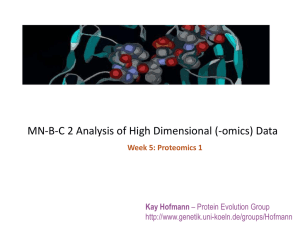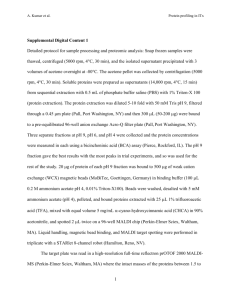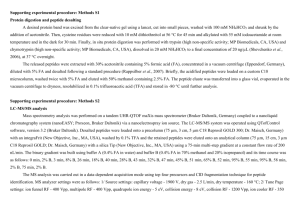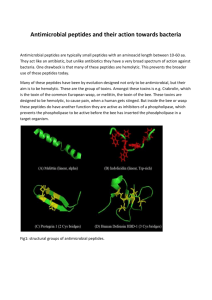pmic12118-sup-0001-SuppMat
advertisement
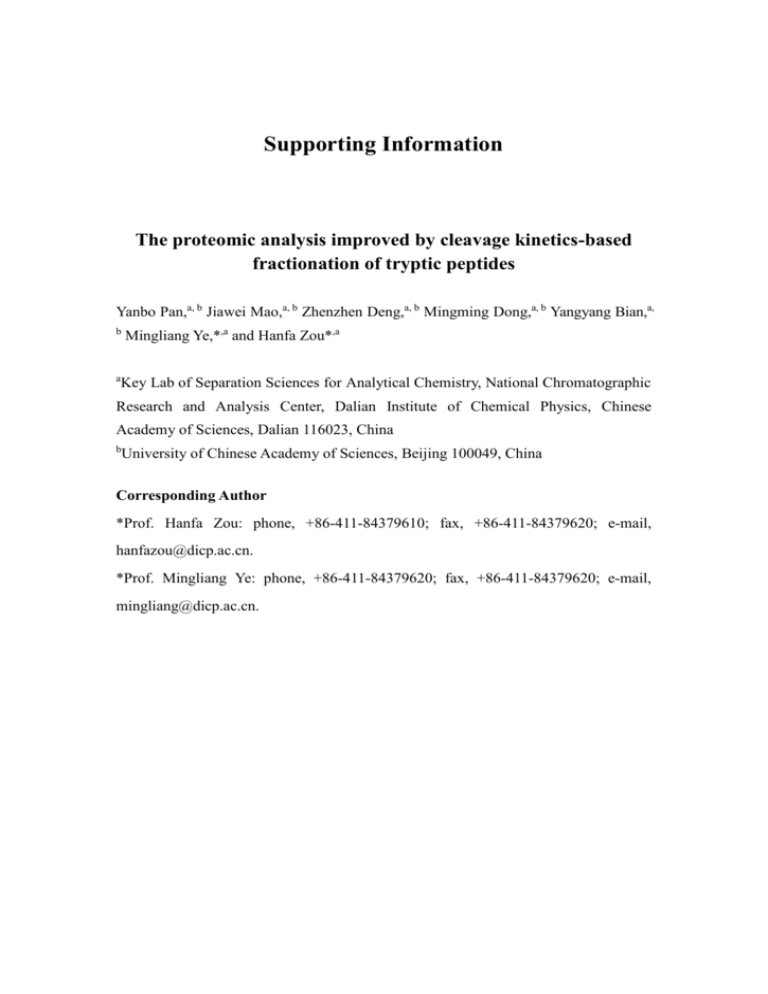
Supporting Information The proteomic analysis improved by cleavage kinetics-based fractionation of tryptic peptides Yanbo Pan,a, b Jiawei Mao,a, b Zhenzhen Deng,a, b Mingming Dong,a, b Yangyang Bian,a, b a Mingliang Ye,*,a and Hanfa Zou*,a Key Lab of Separation Sciences for Analytical Chemistry, National Chromatographic Research and Analysis Center, Dalian Institute of Chemical Physics, Chinese Academy of Sciences, Dalian 116023, China b University of Chinese Academy of Sciences, Beijing 100049, China Corresponding Author *Prof. Hanfa Zou: phone, +86-411-84379610; fax, +86-411-84379620; e-mail, hanfazou@dicp.ac.cn. *Prof. Mingliang Ye: phone, +86-411-84379620; fax, +86-411-84379620; e-mail, mingliang@dicp.ac.cn. Contents: Supplementary Experimental Procedures Supplementary Table and Figures Table S1 The identifications of peptides and proteins from samples 0-4 and control. Fig. S1 The percentages of D and E around the K/R residues revealed by the identified peptide termini (a) and the missed cleavage K/R residues on the identified peptides (b). Fig. S2 Abundance of proteins identified from samples 1-4 and control. Fig. S3 The overlaps of identified peptides (A) and proteins (B) between samples 1-4 and control. Fig. S4 The percentages of peptides with missed cleavage sites in different samples. Fig. S5 Distributions of charges (a) and length (b) for peptides identified from samples 1-4 and control. Fig. S6 Venn diagrams of peptide and protein identifications from samples 1-4. Fig. S7 Venn diagrams of the peptide (a) and protein (b) overlaps between any two samples derived from the four digestion stages. Fig. S8 Base peak chromatograms for RPLC-MS/MS analysis of samples 1-4. Supplementary Experimental Procedures Materials. Urea, tetraethylammonium bromide (TEAB), and trypsin [bovine, treated with L-(tosylamido-2-phenyl)ethyl chloromethyl ketone (TPCK)] were obtained from Sigma-Aldrich (St. Louis, MO), Amiconultra-0.5 mL centrifugal filters was purchased from Millipore (Bedford, MA), Deionized water used for all experiments was prepared using a Mill-Q system (Millipore, Bedford, MA). Extraction of HeLa cell proteins. The HeLa cells were grown and lysed according to previous study.1 The cell pellets were softly homogenized in a cold lysis buffer, sonicated for 120 s (400 W), and centrifuged at 23000g for 1 h. The supernatant containing the total cell proteins was precipitated with five volumes of cold acetone/ethanol/acetic acid (vol/vol/vol = 50/50/0.1) at −20 °C. Protein precipitant was centrifuged at 15000g for 30 min. The pellet was washed separately with acetone and 75% ethanol, then lyophilized to dryness, and stored at −80 °C. Generation of tryptic peptides by using different trypsin concentration and different digestion time. The acquired proteins (100 μg) from HeLa cells were denatured in 100 μL of 8 M urea/100 mM TEAB (pH=8.0), the disulfide bond of proteins was opened by incubating with 10 mM DTT for 1 h at 56 oC and then alkylated by 20 mM IAA in the darkness at room temperature for 40 min. The mixture was diluted to 500 μL with 100 mM TEAB (pH=8.0) and transfer to a centrifugal filter with molecular weight cutoffs of 10000 Da (10 KDa), then centrifuged at 14000g for 20 min. The filtrate was collected and named as sample 0 to detected endogenous peptides. The proteins in centrifugal filter were redissolved in 1.5 M urea/100 mM TEAB (pH=8.0) and trypsin was added at a 2500:1 protein/protease (wt/wt) ratio for digestion at 37 °C. After digested for 15min, it was centrifuged at 14000g for 20 min, and then the filtrate was collected and named as sample 1. The proteins in centrifugal filter were redissolved in 1.5 M urea/100 mM TEAB (pH=8.0) and digest for additional 4h at 37 °C, then centrifuged at 14000g for 20 min, the filtrate was collected and named as sample 2. The proteins in centrifugal filter were redissolved in 1.5 M urea/100 mM TEAB (pH=8.0) and additional trypsin was added at a 50:1protein/protease (wt/wt) ratio for further digestion at 37 °C. After digested for 1h, it was centrifuged at 14000g for 20 min, and the filtrate was collected and named as sample 3. The proteins in centrifugal filter were redissolved in 1.5 M urea/100 mM TEAB (pH=8.0) and digest overnight at 37 °C, then centrifuged at 14000g for 20 min, the filtrate was collected and named as sample 4.The five samples were acidized by 10% TFA and desalted with homemade C18 SPE columns. In a control trypsin digest experiment (control), the same proteins were digested with a 50:1 protein/protease (wt/wt) ratio at 37 °C overnight, ultrafiltered with another centrifugal filter, then acidized by 10% TFA, and desalted with a homemade C18 SPE column. All of the resulting peptide samples were lyophilized to dryness and then stored at -20 oC for further usage. Nano LC-MS/MS analysis. RP LC-MS/MS system consisted of a LTQ-orbitrap Velos mass spectrometer (Thermo Fisher Scientific) with a nanospray source. A capillary column was first manually pulled to a fine point as spray tip, and then packed with C18 AQ beads (5μm, Michrom Bio Resources). 0.1% (v/v) formic acid in water and 0.1 % (v/v) formic acid in acetonitrile were applied as the mobile phase. The gradient elution from 5% to 35% (v/v) of the 0.1% (v/v) formic acid in acetonitrile in 150 min was performed to elute each sample in 1D RPLC-MS/MS. All MS and MS/MS spectra were acquired in the data dependent mode with the twenty most intense ions fragmented by CID. For 2D SCX-RP LC-MS/MS analysis with the LTQ-Orbitrap mass spectrometer (Velos, Thermo Fisher Scientific), a capillary monolithic column (5 cm × 200 μm ID) with phosphate functional groups was applied as an SCX trap column in the first dimension. The sample loading and analysis procedures were as follows: the peptide samples were first dissolved in 0.1% (v/v) formic acid in water, and then loaded onto the monolith SCX trap column; the trap column was equilibrated with 0.1% (v/v) formic acid in water for 10min. After that, it was directly connected to an RP analytical column in tandem by a union. Then four gradient elution steps were applied to gradually elute peptides from the SCX trap column to the RP analytical column with ammonium acetate solution concentrations of 100, 300, 500, and 1000 mM, respectively. After each elution step, a subsequent RPLC-MS/MS was executed in 150 min-gradient time with 0.1% (v/v) formic acid in acetonitrile from 5% to 35% (v/v), a capillary column was first manually pulled to a fine point as spray tip, and then packed with C18 AQ beads (3 μm, 120 Å, Michrom Bio Resources). All MS and MS/MS spectra were acquired in the data dependent mode with the twenty most intense ions were fragmented by CID. Data analysis. Protein identification was performed using MaxQuant (version 1.3.0.5, http://www.maxquant.org).2 The raw files were searched against UniProt database of human downloaded from http://www.uniprot.org (releasedon12/11/2013), carbamidomethylation on cysteine was set as a fixed modification, and oxidation on methionine was set as variable modifications. Peptides were searched using fully tryptic cleavage constraint and up to four missed cleavage sites were allowed, the mass tolerances for the precursor ions and fragment ions were set to 7 ppm and 0.5 Da, respectively. Peptide and protein candidates were filtered to 1% false-discovery rate (FDR). The other settings were the same to the conventional search. Peptide sequences were analysis by WebLogo (http://weblogo.berkeley.edu/logo.cgi). The peptide sequences were centered at the cleavage sites K/R and extended 13 residues (± 6 residues). The N- or C- terminal sequences that could not be extended were excluded. The abundance of identified proteins was provided by PaxDB (http://pax-db.org) 3. References 1. Ye, M.; Pan, Y.; Cheng, K.; Zou, H., Protein digestion priority is independent of protein abundances. Nature methods 2014, 11 (3), 220-222. 2. Cox, J.; Mann, M., MaxQuant enables high peptide identification rates, individualized p.p.b-range mass accuracies and proteome-wide protein quantification. Nature biotechnology 2008, 26 (12), 1367-1372. 3. Wang, M.; Weiss, M.; Simonovic, M.; Haertinger, G.; Schrimpf, S. P.; Hengartner, M. O.; von Mering, C., PaxDb, a Database of Protein Abundance Averages Across All Three Domains of Life. Molecular & Cellular Proteomics 2012, 11 (8), 492-500. Supplementary Table and Figures Table S1 The number of identified peptides and proteins from samples 0-4 and control. Control Sample 0 Sample 1 Sample 2 Sample 3 Sample 4 Peptides 7010 233 6641 13070 12877 7101 Proteins 1566 169 1813 2327 2385 1644 Fig. S1 The percentages of D and E around the K/R residues revealed by the identified peptide termini (a) and the missed cleavage K/R residues on the identified peptides (b). Fig. S2 Abundance of proteins identified from samples 1-4 and control. (The abundance of identified proteins was provided by PaxDB, http://pax-db.org) Fig. S3 The overlaps of identified peptides (A) and proteins (B) between samples 1-4 and control. Fig. S4 The percentages of peptides with missed cleavage sites in different samples. Fig. S5 Distributions of charges (a) and length (b) for peptides identified from samples 1-4 and control. Fig. S6 Venn diagrams of peptide and protein identifications from samples 1-4. The peptides and proteins that only identified from one fractions were region 1, 3, 9, 14. Fig. S7 Venn diagrams of the peptide (a) and protein (b) overlaps between any two samples derived from the four digestion stages. Fig. S8 Base peak chromatograms for RPLC-MS/MS analysis of samples 1-4.


